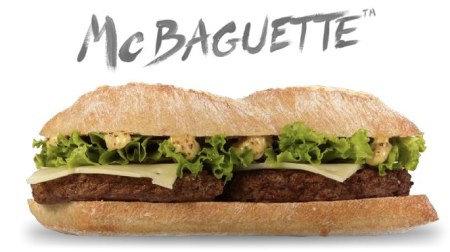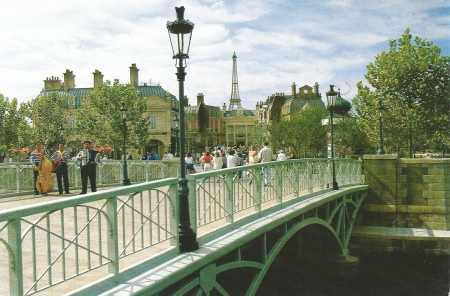“Here you have a city with the World’s most pathologically aggressive drivers and you give them an open space (the Arc de Triomphe) where they can all try and go in any one of thirteen different directions at once. Is that asking for trouble or what?” – Bill Bryson, ‘Neither here nor there’
In September 2002 my son, Jonathan and I took an early morning flight to Paris Charles de Gaulle for a two night stay in the French capital and a plan to see the main sights in just one day. After we arrived we took a train into Paris and then the metro to somewhere near to Montmartre where we were staying in the cheapest hotel that I could find.
As we emerged from the metro station the city was only just beginning to stir into life as the street cleaning machines scrubbed the gutters and North African men in high-visibility jackets swished the pavements with their besom brooms removing the dog mess and the litter in preparation for the day.
It was too early to book into our hotel so we left our bags and went straight back to the metro station stopping for only a very short time at a McDonalds restaurant (did I just call it a restaurant?) for a quick breakfast. And then we joined the commuters making their way to work and took the metro to the Arc de Triomphe where we emerged from the subterranean tunnels into a disappointingly misty Champs Élysée.
The traffic circle surrounding the Arc de Triomphe was extremely intimidating. There are no lanes and none of the usual rules of driving etiquette seemed to apply as hundreds of cars race and weave in and out of each other like dodgem cars at a fairground.
In the nineteenth century after Paris had been destroyed by the Prussian siege in 1870 an architect called Baron Haussemann redesigned Paris with elegant boulevards and long straight roads but although he was a good city planner he wasn’t blessed with foresight because he failed to anticipate the arrival of the motor car and the pathologically aggressive nature of French drivers.
The French have a mad driving rule called priorité à droite where vehicles from the right always have priority at junctions and roundabouts. This rule is in fact so ludicrous that even the French themselves have seen the sense of virtually abandoning elsewhere in the country but it remains the rule here at the busiest roundabout in France (probably) and cars entering the circle have the right-of-way whilst those in the circle must yield. Braking is forbidden and the use of the horn is compulsory, there is no apparent lane discipline that I could make out and entering the roundabout is an extended game of ‘chance’ where drivers simply waited to see whose nerve would fold and who would yield first.
Apparently there is a car accident within the roundabout on average every seven minutes and allegedly there is not a single insurance company in the world that covers accidents within the roundabout. This is the only place in Paris where the accidents are not judged and if there is a prang here, each driver is considered equally at fault. No matter what the circumstances, insurance companies split the costs fifty-fifty.
In France the very desire to own a driving licence should immediately exclude a Frenchman from eligibility to possess one.
We approached the Arch from the Champs Élysée and as far as I could see there was no safe way of crossing and getting to the monument until we eventually found the underground tunnel which took us safely below the traffic chaos above and into the Place de Charles de Gaulle.
We shunned the elevator and climbed the steps instead to the top of the fifty metre high building (the second largest triumphal arch in the World) and enjoyed the views of the boulevards and roads converging and radiating away from this famous landmark. Close by we could see the Eiffel Tower and this was where we were going next.
The Eiffel Tower is an iron lattice tower located on the Champ de Mars and has become both a global icon of France and one of the most recognisable structures in the world. The tower is the tallest building in Paris and the most-visited paid monument in the world.
Named for its designer, engineer Gustave Eiffel, the tower was built as the entrance arch to the 1889 World’s Fair. It is three hundred and twenty-four metres tall, about the same height as an eighty storey high story building. Upon its completion, it surpassed the Washington Monument to assume the title of tallest man-made structure in the world, a title it held for forty-one years, until the Chrysler Building in New York City was built in 1930.
The tower has three levels but we didn’t have time to stand in the queue for the first stage elevator so we took all six hundred steps to the second level and we would have climbed to the very top if we could but the third level is only accessible by an expensive lift.
I guess most people would say that they approve of and like the Eiffel Towere but it wasn’t always so. After it was built the author Guy de Maupassant hated it so much that he often ate lunch in the tower’s second floor restaurant, which was the only point in the city where he couldn’t see “this tall skinny pyramid of iron ladders, this giant and disgraceful skeleton.”
I have visited the Eiffel Tower four times now; in 1979 on a Town Twinning visit to Evreux in Normandy, in 1989 on a weekend trip with some work colleagues to celebrate a new career, this occasion and finally in 2004, the last time that I visited Paris. Unfortunately on every occasion the weather has been overcast and I have never enjoyed the clear views that should really be possible from the top.
Back at ground level the sun was beginning to break through as we crossed the River Seine and onto the Champs de Mars and as it was approaching lunchtime we found a restaurant with pavement tables in the sun and ordered a pizza. The food was reasonably priced but I remember a large glass of beer cost €8 so I made a mental note to find a mini-market on the way back to the hotel for more sensibly priced alcohol for the evening.
Our next stop was Notre Dam Cathedral but as we had walked quite a distance already we took a Batou Mouche barge ride the short distance the River to the Ile de Cîte and as the vessel made its way through the centre of the city we soaked up the historic sites along both banks from the viewing platform at the back which was crowded now because the mist had finally gone and there was full sunshine and a blue sky.
Although we had already climbed to the top of the Arc de Triomphe and half way up the Eiffel Tower we bought tickets and waited in line to climb to the top of the Cathedral but sadly by the time we reached the top and walked around the external galleries the mist had returned and wrapped Paris in a gloomy grey shroud again.
Jonathan was beginning to flag by now and as it was late afternoon we walked a little further around the streets of old Paris and then took a metro back to Montmartre where we walked along the boulevard with its seedy sex establishments and grubby shops and into the touristy cobbled back streets of the district famous for painters, night-life and a red-light district.
The plan was to find somewhere to eat but he was so tired that he preferred my suggestion of returning to the hotel and I would fetch a McDonalds meal from around the corner and we would just stay in and crash! So we did just that.
Even though the French maintain that they despise the Company and the concept of fast food an awful lot of people eat there. Across France today there are nearly twelve hundred restaurants and in Paris alone there are almost seventy restaurants under golden arches, with even more dotted around the outer suburbs. That’s much the same as London, but with only a third of the population.

In just one year the chain’s French revenues increased by 11 per cent to €3 billion. That’s more than it generates in Britain and in terms of profit, France is second only to the United States itself. It is now so firmly a part of French culture that in 2009 McDonald’s reached a deal with the French museum, the Louvre, to open a McDonald’s restaurant and McCafé on its premises by their underground entrance.
It had been an excellent day in Paris but a tiring one and as we reflected on the day we dubbed it ‘Speed Sightseeing’ and we successfully employed this method again in 2003 in Amsterdam and then in 2004 in Rome.









